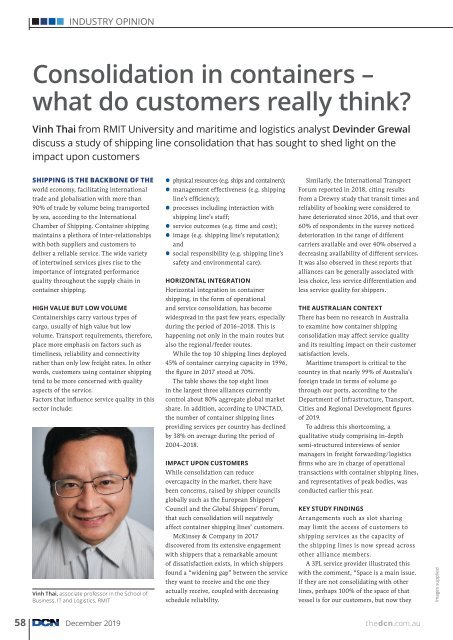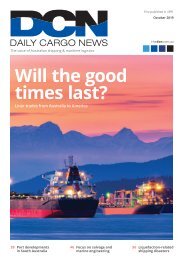DCN December Edition 2019
Create successful ePaper yourself
Turn your PDF publications into a flip-book with our unique Google optimized e-Paper software.
INDUSTRY OPINION<br />
Consolidation in containers –<br />
what do customers really think?<br />
Vinh Thai from RMIT University and maritime and logistics analyst Devinder Grewal<br />
discuss a study of shipping line consolidation that has sought to shed light on the<br />
impact upon customers<br />
SHIPPING IS THE BACKBONE OF THE<br />
world economy, facilitating international<br />
trade and globalisation with more than<br />
90% of trade by volume being transported<br />
by sea, according to the International<br />
Chamber of Shipping. Container shipping<br />
maintains a plethora of inter-relationships<br />
with both suppliers and customers to<br />
deliver a reliable service. The wide variety<br />
of intertwined services gives rise to the<br />
importance of integrated performance<br />
quality throughout the supply chain in<br />
container shipping.<br />
HIGH VALUE BUT LOW VOLUME<br />
Containerships carry various types of<br />
cargo, usually of high value but low<br />
volume. Transport requirements, therefore,<br />
place more emphasis on factors such as<br />
timeliness, reliability and connectivity<br />
rather than only low freight rates. In other<br />
words, customers using container shipping<br />
tend to be more concerned with quality<br />
aspects of the service.<br />
Factors that influence service quality in this<br />
sector include:<br />
Vinh Thai, associate professor in the School of<br />
Business, IT and Logistics, RMIT<br />
physical resources (e.g. ships and containers);<br />
• management effectiveness (e.g. shipping<br />
line’s efficiency);<br />
• processes including interaction with<br />
shipping line’s staff;<br />
service outcomes (e.g. time and cost);<br />
• image (e.g. shipping line’s reputation);<br />
and<br />
• social responsibility (e.g. shipping line’s<br />
safety and environmental care).<br />
HORIZONTAL INTEGRATION<br />
Horizontal integration in container<br />
shipping, in the form of operational<br />
and service consolidation, has become<br />
widespread in the past few years, especially<br />
during the period of 2016–2018. This is<br />
happening not only in the main routes but<br />
also the regional/feeder routes.<br />
While the top 10 shipping lines deployed<br />
45% of container carrying capacity in 1996,<br />
the figure in 2017 stood at 70%.<br />
The table shows the top eight lines<br />
in the largest three alliances currently<br />
control about 80% aggregate global market<br />
share. In addition, according to UNCTAD,<br />
the number of container shipping lines<br />
providing services per country has declined<br />
by 38% on average during the period of<br />
2004–2018.<br />
IMPACT UPON CUSTOMERS<br />
While consolidation can reduce<br />
overcapacity in the market, there have<br />
been concerns, raised by shipper councils<br />
globally such as the European Shippers’<br />
Council and the Global Shippers’ Forum,<br />
that such consolidation will negatively<br />
affect container shipping lines’ customers.<br />
McKinsey & Company in 2017<br />
discovered from its extensive engagement<br />
with shippers that a remarkable amount<br />
of dissatisfaction exists, in which shippers<br />
found a “widening gap” between the service<br />
they want to receive and the one they<br />
actually receive, coupled with decreasing<br />
schedule reliability.<br />
Similarly, the International Transport<br />
Forum reported in 2018, citing results<br />
from a Drewry study that transit times and<br />
reliability of booking were considered to<br />
have deteriorated since 2016, and that over<br />
60% of respondents in the survey noticed<br />
deterioration in the range of different<br />
carriers available and over 40% observed a<br />
decreasing availability of different services.<br />
It was also observed in these reports that<br />
alliances can be generally associated with<br />
less choice, less service differentiation and<br />
less service quality for shippers.<br />
THE AUSTRALIAN CONTEXT<br />
There has been no research in Australia<br />
to examine how container shipping<br />
consolidation may affect service quality<br />
and its resulting impact on their customer<br />
satisfaction levels.<br />
Maritime transport is critical to the<br />
country in that nearly 99% of Australia’s<br />
foreign trade in terms of volume go<br />
through our ports, according to the<br />
Department of Infrastructure, Transport,<br />
Cities and Regional Development figures<br />
of <strong>2019</strong>.<br />
To address this shortcoming, a<br />
qualitative study comprising in-depth<br />
semi-structured interviews of senior<br />
managers in freight forwarding/logistics<br />
firms who are in charge of operational<br />
transactions with container shipping lines,<br />
and representatives of peak bodies, was<br />
conducted earlier this year.<br />
KEY STUDY FINDINGS<br />
Arrangements such as slot sharing<br />
may limit the access of customers to<br />
shipping services as the capacity of<br />
the shipping lines is now spread across<br />
other alliance members.<br />
A 3PL service provider illustrated this<br />
with the comment, “Space is a main issue.<br />
If they are not consolidating with other<br />
lines, perhaps 100% of the space of that<br />
vessel is for our customers, but now they<br />
Images supplied<br />
58 <strong>December</strong> <strong>2019</strong><br />
thedcn.com.au
















